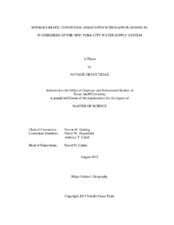| dc.description.abstract | The New York City Water Supply System, partially sourced in the Catskill Mountains, NY, is an interconnected series of reservoirs, managed lakes, and aqueducts that serve a population of over 9 million residents in the New York City metropolitan area. This water supply system is unfiltered, as constructing and operating a water filtration facility to support this volume of water would be prohibitively expensive. Because of the unfiltered status, the water supply system is particularly vulnerable to changes in water quality. One such change may occur with flash flooding, which rapidly increases the turbidity of the water and decreases its quality beyond what is allowed in the water supply system.
This thesis seeks to understand flash flooding in these watersheds. In Objective 1, USGS 15-minute discharge data from two similar and adjacent watersheds were analyzed for flash floods from 1987-2014. A total of 32 flash flood peaks were detected in the two watersheds over 23 days. These flash flood events were related to hydrometeorological conditions. In Objective 2, unique synoptic-scale patterns (“synoptic types”) were developed with NCEP/NCAR 500 mb geopotential height analyses data. When these 17 types were associated with flash flood events, a statistically significant relationship between types of a southwesterly flow was observed. This pressure gradient occurred significantly more frequently than normal in the days preceding flash floods. Another type, associated with an approaching ridge, was observed significantly less than normal in the days preceding flash flood events. In Objective 3, a relationship between basic hydrometeorological variables and flash flood peak discharge was sought. Regression analyses showed that antecedent soil moisture and precipitation intensity over the 24 hours preceding the flash flood peak explained 42% of the variance in the peak discharge.
The novelty of this research largely lies with the synthesis of both synoptic scales and local scales in regard to understanding flash flood occurrence and magnitude in the Catskill Mountains, NY. The conclusions of this thesis provide information that could be utilized by watershed managers to improve understanding of flash floods in this water supply system. Direction and suggestions for future work are also provided. | en |


